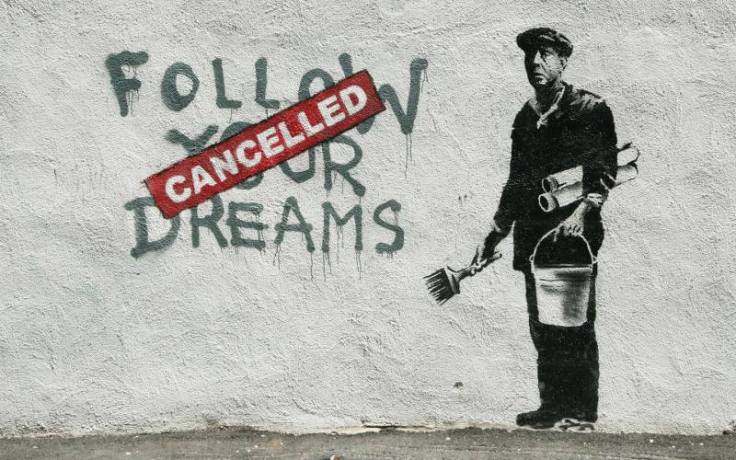Banksy started out as a graffiti artist in the early 90’s at the age of fourteen. The street art craze had been brought to the UK by a member of the British band “Massive Attack” and in Banksy’s home town of Bristol it was becoming a popular pastime. The style of graffiti had been imported from New York and was mainly based around tags and statements created using bold, colourful text. Banksy has stated that the reason he started creating graffiti was to have himself heard, as a teenager he was looking for a way to make his mark on the world. He was renowned locally for placing his artworks in the most inaccessible places, something that his peers had thought he would never get away with, but he did time and time and time again. Banksy confesses that he was not very good at lettering so soon moved to using stencils for accuracy and speed, allowing him to create interesting artworks and avoid the police. This is the move that began to transform Banksy into the artist that we see today, his stencils gave him a style set apart from other street artists, he was able to say more, more quickly. Many of his contemporaries believed that he was corrupting the purist form of street art but many of these artists ended up eventually following in his footsteps. Banksy moved to London where some of his artworks left the walls he had become accustomed to and began to involve ares of public interest such as statues, parks and lakes. His work was beginning to include installation style pieces to compliment his graffiti. Banksy was turning the constant barrage of signage and adverts into a two way conversation using humour and satire to poke fun at the establishment. The main launchpad for his current success was his decision to bypass the traditional gallery system by covertly hanging his own work in Tate Britain confirming himself as a rebel artist.
The message of his work is usually anti-war, anti-establishment or anti-capitalism, they are often humorous and appear facetious. In more recent years he has included sculptures, paintings and installations in his work. He has maintained anonymity throughout his career which has given him the freedom to stay true to his convictions and helped him gain huge popularity and notoriety, now selling his art for hundreds of thousands of pounds. He maintains that it is not about the money but it is unclear how much he has earned and what he does with his wealth, it is estimated that he could be worth over fifteen million pounds. Banksy has created works on the Israeli West Bank wall several times between 2005 and 2017 which, among other global statements, has made him a household name worldwide.
His latest installation is the “Walled Off Hotel” in the poorest part of Palestine which is a permanent installation featuring many works of art that have a politically satirical message. The walls inside are covered with paintings, murals and installations with a humorous slant on a very serious subject. These include a painting of Jesus looking crosseyed at the crosshair in the middle of his forehead, a mural of two soldiers having a pillow fight and a wall covered with a range of different CCTV cameras. One of the stand out pieces is a water tank that is part of bathtub. The tank is full of bullet holes that let the water flow into the bath below. This is a comment on an incident in which Israeli soldiers apparently fired upon West Bank water tanks, to empty them and cause the Palestinian suffering. Banksy has made reference to the political situation in the area and the legacy of the British intervention after World War I.
“It’s exactly one hundred years since Britain took control of Palestine and started re-arranging the furniture, with chaotic results. I don’t know why, but it felt like a good time to reflect on what happens when the United Kingdom makes a huge political decision without fully comprehending the consequences.”
This could also be a reference to several different relatively recent political situations involving Britain including “Brexit” and the invasion of Iraq.
Personally I’m a big fan of the “classic” Banksy, comical black and white images on run-down looking walls, often using an existing focal point to base the piece around. The images look ambiguous at a glance but his statement soon becomes apparent. Making a serious point in a flippant way makes the viewer contemplate the subject without telling them what to think, Banksy plants a seed and lets the viewer grow the opinion for them self. Street art has the freedom of not being a money making enterprise, it is not designed to be sold and moved, it is solely a vehicle for expressing an opinion or emotion; this could be considered to be art in it’s purest form.
Banksy’s work could apply to my own projects, giving a simple and clear message in an interesting and visually appealing way. It draws the viewer in and creates interest and impact often in an environment containing the issues it is drawing attention to. My “Zine” project involves an issue which I feel strongly about, I don’t know what I’m going to do yet but looking at Banksy’s work has got me thinking. Maybe I should think about working in closer proximity to the subject, making it part of the surroundings for my work, a focal point to work from. Or trying a more flippant and approach, rather than telling people what they should or shouldn’t do I could humourise the point to win people over.

Bibliography
Banksy. (2006). Banksy. London, England: Century.
Banksy Documentary. (2018). Retrieved from https://www.youtube.com/watch?v=evbHCAn4jto
Banksy. (2018). Retrieved from https://en.wikipedia.org/wiki/Banksy
B-Movie: a short film about Banksy. (2018). Retrieved from https://www.youtube.com/watch?v=NG1cys05dGY
Banksy documentary: Welcome to the Banksy art hotel in Bethlehem. (2018). Retrieved from https://www.youtube.com/watch?v=CMS6Ds3qryY

Leave a comment